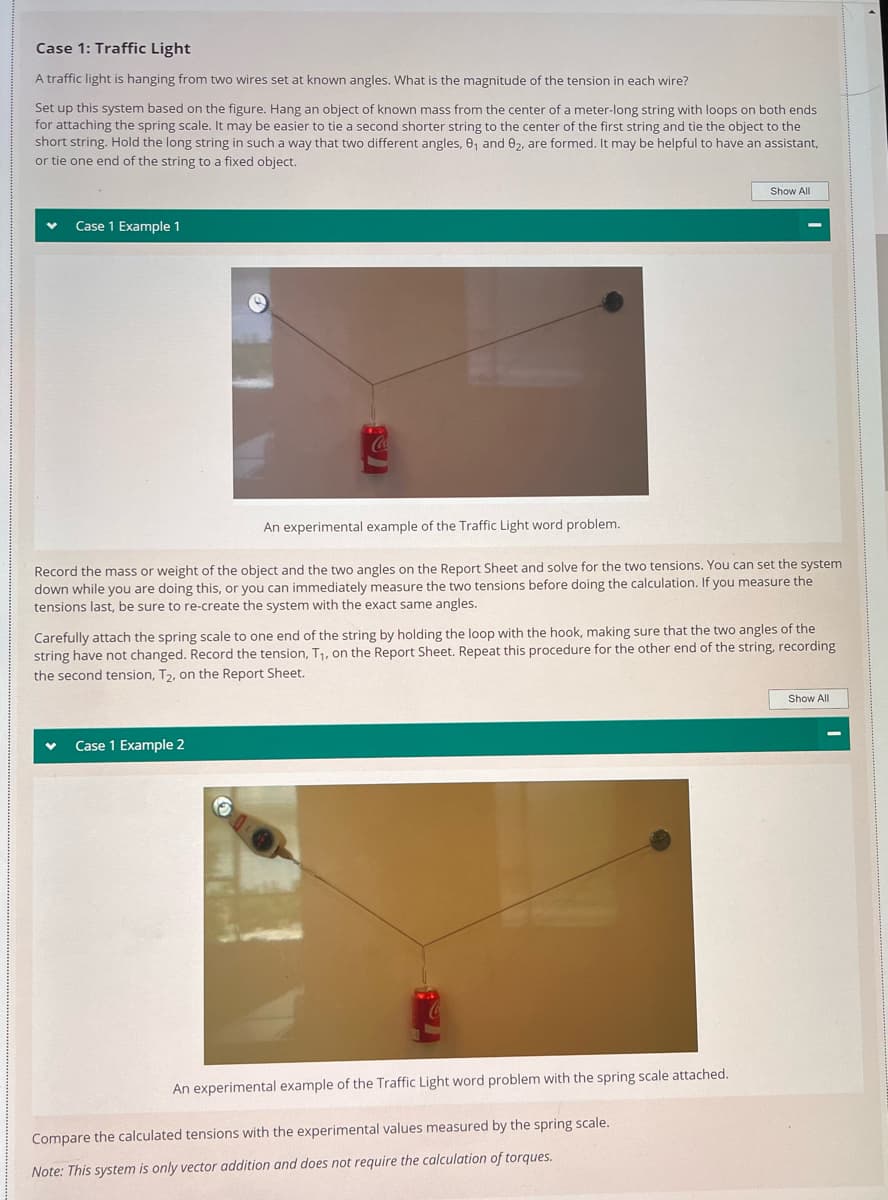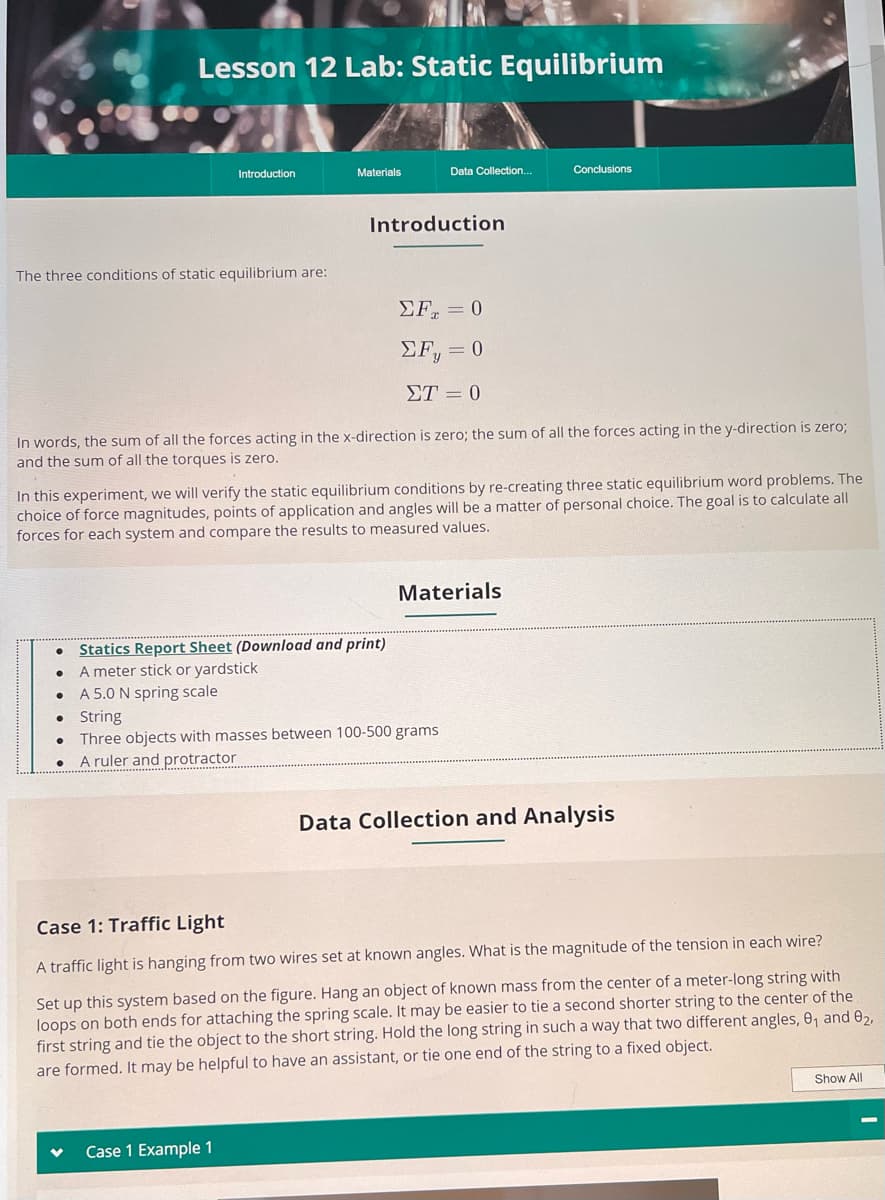A traffic light is hanging from two wires set at known angles. What is the magnitude of the tension in each wire? Set up this system based on the figure. Hang an object of known mass from the center of a meter-long string with loops on both ends for attaching the spring scale. It may be easier to tie a second shorter string to the center of the first string and tie the object to the short string. Hold the long string in such a way that two different angles, 9₁ and 92, are formed. It may be helpful to have an assistant, or tie one end of the string to a fixed obiect.
A traffic light is hanging from two wires set at known angles. What is the magnitude of the tension in each wire? Set up this system based on the figure. Hang an object of known mass from the center of a meter-long string with loops on both ends for attaching the spring scale. It may be easier to tie a second shorter string to the center of the first string and tie the object to the short string. Hold the long string in such a way that two different angles, 9₁ and 92, are formed. It may be helpful to have an assistant, or tie one end of the string to a fixed obiect.
College Physics
1st Edition
ISBN:9781938168000
Author:Paul Peter Urone, Roger Hinrichs
Publisher:Paul Peter Urone, Roger Hinrichs
Chapter10: Rotational Motion And Angular Momentum
Section: Chapter Questions
Problem 17PE: An automobile engine can produce 200 N m of torque. Calculate the angular acceleration produced if...
Related questions
Question
100%
Case 1 traffic light:
Weight of hanging object: 370g
Angle 1: 130 degrees
Angle 2: 100 degrees
Measured tension 1: 3.0 N
Measured tension 2: 4.2 N
Please answer with equations and calculations.

Transcribed Image Text:Case 1: Traffic Light
A traffic light is hanging from two wires set at known angles. What is the magnitude of the tension in each wire?
Set up this system based on the figure. Hang an object of known mass from the center of a meter-long string with loops on both ends
for attaching the spring scale. It may be easier to tie a second shorter string to the center of the first string and tie the object to the
short string. Hold the long string in such a way that two different angles, 8₁ and 92, are formed. It may be helpful to have an assistant,
or tie one end of the string to a fixed object.
Case 1 Example 1
An experimental example of the Traffic Light word problem.
Record the mass or weight of the object and the two angles on the Report Sheet and solve for the two tensions. You can set the system
down while you are doing this, or you can immediately measure the two tensions before doing the calculation. If you measure the
tensions last, be sure to re-create the system with the exact same angles.
Show All
Carefully attach the spring scale to one end of the string by holding the loop with the hook, making sure that the two angles of the
string have not changed. Record the tension, T₁, on the Report Sheet. Repeat this procedure for the other end of the string, recording
the second tension, T₂, on the Report Sheet.
Case 1 Example 2
An experimental example of the Traffic Light word problem with the spring scale attached.
Compare the calculated tensions with the experimental values measured by the spring scale.
Note: This system is only vector addition and does not require the calculation of torques.
Show All

Transcribed Image Text:The three conditions of static equilibrium are:
Lesson 12 Lab: Static Equilibrium
●
●
Introduction
●
Materials
In words, the sum of all the forces acting in the x-direction is zero; the sum of all the forces acting in the y-direction is zero;
and the sum of all the torques is zero.
Introduction
In this experiment, we will verify the static equilibrium conditions by re-creating three static equilibrium word problems. The
choice of force magnitudes, points of application and angles will be a matter of personal choice. The goal is to calculate all
forces for each system and compare the results to measured values.
Data Collection...
Statics Report Sheet (Download and print)
A meter stick or yardstick
A 5.0 N spring scale
Case 1 Example 1
ΣF = 0
ΣF, = 0
ΣΤ = 0
● String
Three objects with masses between 100-500 grams
A ruler and protractor
Conclusions
Materials
Data Collection and Analysis
Case 1: Traffic Light
A traffic light is hanging from two wires set at known angles. What is the magnitude of the tension in each wire?
Set up this system based on the figure. Hang an object of known mass from the center of a meter-long string with
loops on both ends for attaching the spring scale. It may be easier to tie a second shorter string to the center of the
first string and tie the object to the short string. Hold the long string in such a way that two different angles, 0₁ and 0₂,
are formed. It may be helpful to have an assistant, or tie one end of the string to a fixed object.
Show All
Expert Solution
This question has been solved!
Explore an expertly crafted, step-by-step solution for a thorough understanding of key concepts.
This is a popular solution!
Trending now
This is a popular solution!
Step by step
Solved in 2 steps with 2 images

Knowledge Booster
Learn more about
Need a deep-dive on the concept behind this application? Look no further. Learn more about this topic, physics and related others by exploring similar questions and additional content below.Recommended textbooks for you

College Physics
Physics
ISBN:
9781938168000
Author:
Paul Peter Urone, Roger Hinrichs
Publisher:
OpenStax College

Physics for Scientists and Engineers, Technology …
Physics
ISBN:
9781305116399
Author:
Raymond A. Serway, John W. Jewett
Publisher:
Cengage Learning

Glencoe Physics: Principles and Problems, Student…
Physics
ISBN:
9780078807213
Author:
Paul W. Zitzewitz
Publisher:
Glencoe/McGraw-Hill

College Physics
Physics
ISBN:
9781938168000
Author:
Paul Peter Urone, Roger Hinrichs
Publisher:
OpenStax College

Physics for Scientists and Engineers, Technology …
Physics
ISBN:
9781305116399
Author:
Raymond A. Serway, John W. Jewett
Publisher:
Cengage Learning

Glencoe Physics: Principles and Problems, Student…
Physics
ISBN:
9780078807213
Author:
Paul W. Zitzewitz
Publisher:
Glencoe/McGraw-Hill

Principles of Physics: A Calculus-Based Text
Physics
ISBN:
9781133104261
Author:
Raymond A. Serway, John W. Jewett
Publisher:
Cengage Learning

Physics for Scientists and Engineers
Physics
ISBN:
9781337553278
Author:
Raymond A. Serway, John W. Jewett
Publisher:
Cengage Learning

Physics for Scientists and Engineers with Modern …
Physics
ISBN:
9781337553292
Author:
Raymond A. Serway, John W. Jewett
Publisher:
Cengage Learning